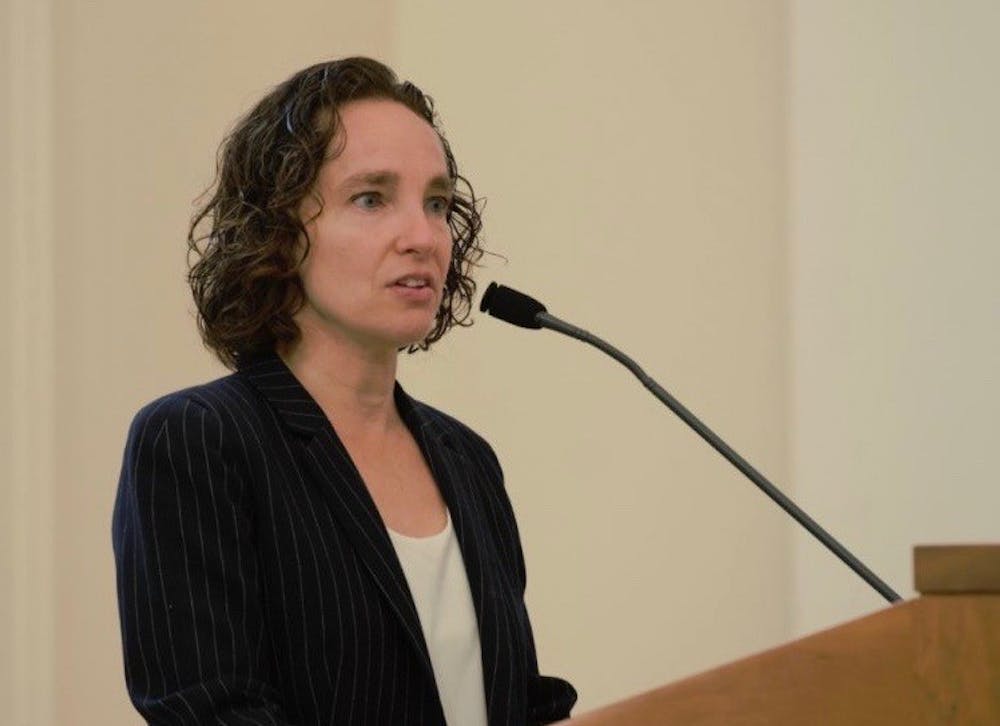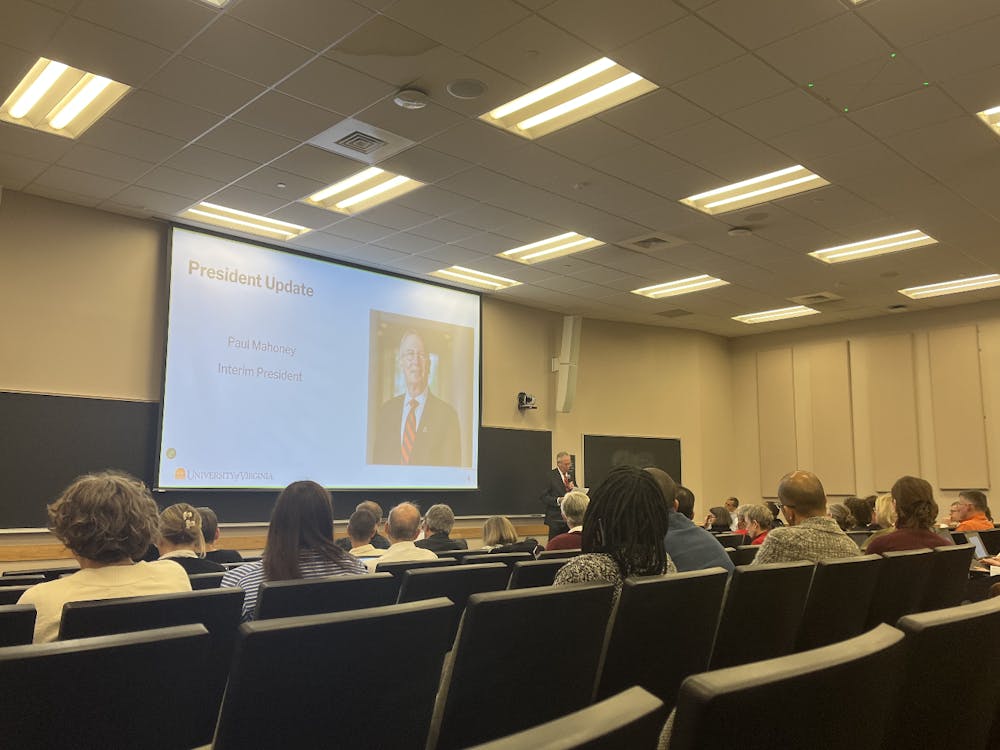Several professors and experts from schools and departments throughout the University and higher education institutions around the country convened at the Law School Friday to reflect on the white supremacist rallies of Aug. 11 and 12, 2017 through a variety of panel discussions regarding critical race theory in the U.S.
The event was co-sponsored by the Carter G. Woodson Institute, the Center for the Study of Race and Law, the Virginia Law Review and the School of Law.
Risa Goluboff, dean of the Law School and former chair of the Deans Working Group, delivered a keynote address, which provided a legal and political explanation for the white supremacist demonstrations.
“I’m guessing that few people in this room, and few African-Americans anywhere, were particularly surprised by the white supremacy that reared out violent and deadly last August,” Goluboff said. “Even if one might have been surprised, or perhaps the better word is shocked … by the particular form that it took and [were] horrified by that form and the violence that it did.”
Goluboff said there is an overwhelming but false narrative in the U.S. that the legal and political victories of the American Civil Rights Movement — such as the Brown v. Board of Education decision and the Voting Rights Act of 1964 — ended racial strife in America.
However, Goluboff said that these milestones, while crucial to achieving a certain measure of legal political and social inequality in the U.S., were largely incomplete in addressing many other forms of injustice, such as economic and housing inequality.
“But it was a surprise to many because … of so much that could no longer be remembered in the dominant stories about ourselves,” Goluboff said. “For many Americans, that meant thinking that white supremacy was part of our past and not our present. And our historical narratives and our legal doctrines allowed us to affirm that belief, [and] they in fact made that belief possible.”
Goluboff added that the white supremacist rallies of August 2017 were only the latest and most visible manifestation of modern American white supremacy, which she said enabled many people to confront the reality of ongoing racial inequality in the U.S.
“The confirmation last August that the most visible form of racism exists shows what you all have been studying and saying for decades: that racism and white supremacy persist,” Goluboff said. “That it is not an equal society in which this type of violent and virulent racism episodically shows up out of nowhere, [but] it is actually showing up because it is there all the time.”
During a panel discussion regarding the physical and biological origins of American white supremacy and racism, Annette Gordon-Reed — a professor of American legal history at Harvard Law School — said white supremacy and racism are fundamental to the understanding of the country’s founding and development.
“When we think about white supremacy … it’s something that has been part of the American nation from the very beginning,” Reed said. “The unequal humanity of African-American people was there from the beginning.”
In particular, Reed said Charlottesville and the University were key components of this racist history, given Thomas Jefferson’s association with the area as the founder of the University and owner of the Monticello estate where over 700 individuals were enslaved.
Reed added that while Jefferson embodies ideals of human equality and freedom for individuals that inspire individuals of all racial categories, he inevitably attracts the admiration of hate groups as well due to his complex legacy.
“It was no wonder that these people who marched came here as unfortunate as that was,” Reed said. “[They were] marching towards the statue of Jefferson because Jefferson represented something to them that Jefferson represents to other people as well. There is a dual legacy that sort of embodies the American dilemma.”
More specifically, Reed said that while Jefferson seemed to view slavery as a moral crime and African-Americans as morally equal to whites, there is evidence he believed African-Americans were not equal to whites in terms of capability — an ideal which Reed said persists today and emboldened the white supremacists who demonstrated in Charlottesville.
“The sort of hidden notion that drove slavery, that drove Jim Crow [is] the idea of black inferiority that people think is gone [but] is actually there,” Reed said. “The notion that whites look better than blacks, whites are smarter than blacks, whites are more worthy than blacks — this is not something that, if we are honest with ourselves, are ideas that are far out on the margin. These are things that are still with us, and we grapple with all the time.”
During the conference, Theodore Shaw, the director for the Center of Civil Rights at the University of North Carolina at Chapel Hill, spoke on the racist history embodied by monuments and memorials to Confederate generals throughout the southern United States.
In Chapel Hill, a monument to a Confederate soldier on the UNC campus known as “Silent Sam” was torn down by students and activists in August after years of controversy surrounding the statue and its legacy.
Shaw said the statue was originally erected in 1913 by the Daughters of the American Revolution with the explicit purpose of intimidating African-Americans in the Chapel Hill community. Shaw added that statues of Confederate Generals Robert E. Lee and Thomas “Stonewall” Jackson in downtown Charlottesville serve the same purpose.
Currently, the Lee and Jackson statues are the subjects of a lawsuit filed against the City of Charlottesville last year after the City Council voted to remove the statues. The next hearing in the suit is scheduled for January 2019 in the Charlottesville Circuit Court.
“The struggle that we've been having in this country with respect to slavery, Jim Crow segregation is an ongoing struggle,” Shaw said. “That statue meant something very clear to African-Americans when it was erected, and it was intended that way.”
Shaw also said he has white ancestors who have been in the U.S. since the Revolutionary War, but added that familial lineage was not necessarily reason to honor one’s ancestry.
“If the people who honor the Confederacy and Silent Sam, and the people who marched here in Charlottesville say they were honoring their ancestors — I too have Confederate ancestors and slave owning ancestors,” Shaw said. “We don't have to honor everything our ancestors do. We’re not responsible for what they did, only responsible for what we do in our time.”
However, Shaw said he was a student of history himself and has visited numerous monuments and memorials to Confederate soldiers and Civil War battles throughout the U.S.
“I believe that we should not whitewash history,” Shaw said. “I'll continue to go to all of these historic places … but we ought not be honoring these people and what they stood for and what they did — they betrayed our country. That’s what was at issue last year in Charlottesville.”







